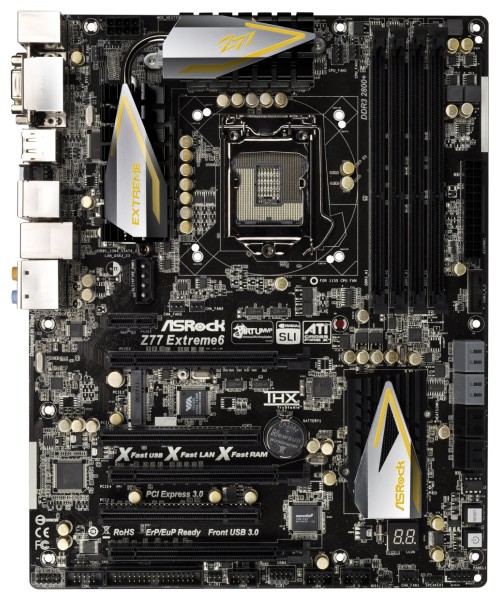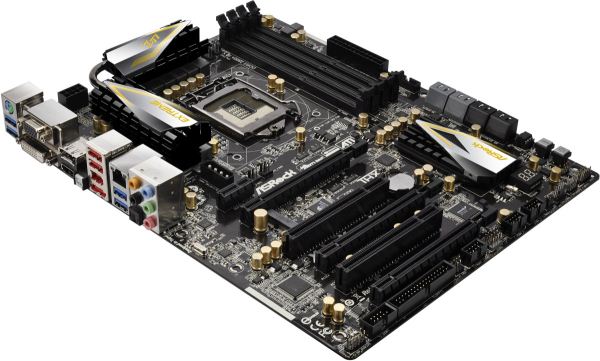Intel Z77 Panther Point Chipset and Motherboard Preview – ASRock, ASUS, Gigabyte, MSI, ECS and Biostar
by Ian Cutress on April 8, 2012 12:00 AM EST- Posted in
- Motherboards
- Intel
- Biostar
- MSI
- Gigabyte
- ASRock
- Asus
- Ivy Bridge
- ECS
- Z77
ASRock Z77 Extreme6—Visual Inspection
With the Extreme6, compared to the Extreme4, there are a significant number of changes, both visual and in terms of features. For a start, the heatsink design is more pronounced, using something similar to their X79 range in terms of black and gold ridged and edged surfaces. The VRM heatsink design is more substantial than the Extreme4, even though online it states it is still only an 8 + 4 VRM design—actually looking at the board, it seems more of a 10 + 4 design.
By looking at the motherboard, you would assume that it would support three-GPU setups. Unfortunately, this third full-length PCIe lane is only PCIe 2.0 x4, rather than splitting up the PCIe 3.0 lanes x8/x4/x4 or using a PLX chip. The MSRP for this board should be around $177, indicating that perhaps that is too cheap a board for one of the expensive PCIe 3.0 expansion PLX chips.

Onboard is also an mSATA port, right in the middle between the first PCIe slot and the PCI slot. Above the PCIe slots is a 4-pin molex power connector to provide extra power to the PCIe slots, although I am kind of getting tired of seeing it put in this location. If anything, it should be at the bottom end or beside the 24-pin power connector, as having it above the PCIe slots just means that there will be cables all over the place.
One other less obvious change to the Extreme4 is that there is a Floppy drive header on board. Yes, you heard me right—floppy drive! It seems odd now to include this legacy connection. It still has a place in industrial concepts (where a machine uses floppy drives and costs 1000x more than the PC processing its data), but not particularly on a higher end product which may be geared towards gaming and overclocking. Perhaps if ASRock are the only ones, then it creates a niche just for them.
In terms of fan headers on board, we have one three-pin beside the 8-pin 12V power connector, two CPU headers (one 4-pin, one 3-pin) just to the right of the top heatsink, two chassis three-pin headers beside the molex connector, and another 4-pin chassis header on the bottom of the board. On the right hand side, the USB 3.0 connector has been placed beneath the 24-pin ATX power connector, followed by the SATA ports. Like the Extreme4, we have the PCH SATA ports (two SATA 6 Gbps and four SATA 3 Gbps) and two extra SATA 6 Gbps from an ASMedia ASM1061 controller.
Around the larger chipset heatsink, we have power/reset buttons and a two digit debug display, both of which I personally like to see as a reviewer (makes my job a bit easier) but also helps overclockers. On the south side of the board, apart from that floppy connector I mentioned, we have a COM port, front panel audio, and an array of USB 2.0 headers.
PCIe layout is similar to the Extreme6, with a PCIe x1, PCIe 3.0 x16/x8, an mSATA connector, PCI, PCIe 3.0 x8, PCI, and a PCI 2.0 x4. This allows a user to use a dual GPU setup, and still have access to a PCIe x1 and x4.

Aside from the bowed picture from ASRock, we have something similar to the Extreme4 for the IO back panel, though this time with a DisplayPort output. From left to right, we have a combination PS/2 port, two USB 3.0 ports (blue), a D-Sub port, DVI-D, DisplayPort, HDMI, a ClearCMOS button, two USB 2.0 (red), an IEEE1394 port, eSATA, gigabit Ethernet, two more USB 3.0 (blue), and audio outputs including an optical SPDIF.
Board Features
| ASRock Z77 Extreme6 | |
| Size | ATX |
| CPU Interface | LGA-1155 |
| Chipset | Intel Z77 |
| Power Delivery | 8 + 4 |
| Memory Slots |
Four DDR3 DIMM slots supporting up to 32 GB Up to Dual Channel, 1066-2800 MHz |
| Video Outputs | DisplayPort, HDMI 1.4a, DVI-D, D-Sub |
| Onboard LAN | Broadcom BCM57781 |
| Onboard Audio | Realtek ALC898 |
| Expansion Slots |
2 x PCIe x16 Gen3 (x16, x8/8) 1 x PCIe x16 Gen2 (x4) 1 x PCIe x1 Gen2 2 x PCI 1 x mini PCIe |
| Onboard SATA/RAID |
2 x SATA 6 Gbps (PCH), Support for RAID 0, 1, 5, 10 2 x SATA 6 Gbps (ASMedia ASM1061) 4 x SATA 3 Gbps (PCH), Support for RAID 0, 1, 5, 10 |
| USB |
Two USB 3.0 at rear (PCH) Two USB 3.0 at rear (Etron EJ168A) One USB 3.0 header (PCH) |
| Onboard |
4 x SATA 6 Gbps 4 x SATA 3 Gbps 1 x Floppy Connector 1 x IR Header 1 x CIR Header 1 x COM Header 1 x SPDIF Header 1 x 4-pin Molex power connector Power/Reset Buttons Two Digit Debug LED 6 x Fan Headers Front panel audio connector 3 x USB 2.0 headers (support 6 USB 2.0 ports) 1 x USB 3.0 header (supports 2 USB 3.0 ports) |
| Power Connectors |
1 x 24-pin ATX connector 1 x 8-pin 12V connector 1 x 4-pin Molex for PCIe |
| Fan Headers |
2 x CPU Fan Header (one 4-pin, one 3-pin) 3 x CHA Fan Headers (one 4-pin, two 3-pin) 1 x SYS Fan Header (one 3-pin) |
| IO Panel |
1 x Combo PS/2 Port 1 x DisplayPort 1 x HDMI 1.4a 1 x DVI-D 1 x D-Sub 1 x Optical SPDIF 2 x USB 2.0 4 x USB 3.0 1 x IEEE1394 1 x Gigabit Ethernet 1 x Clear CMOS Audio Outputs |
| Warranty Period | 3 years from date of purchase |
| Product Page | Link |
Nothing immediately jumps out from the board features list aside from the differences to the Extreme4. This is a quite good package for an MSRP of $171.











145 Comments
View All Comments
Iketh - Sunday, April 8, 2012 - link
I'm curious how Skyrim behaves with this Lucid technology, since physics and framerate are linked for whatever reason... (if you disable Skyrim's 60 fps cap and point the camera in a direction that gives you 150+ FPS for example, everything that is moveable nearby starts to rattle and fall off shelves...)Xale - Sunday, April 8, 2012 - link
Games with their own framerate limits should not be affected, as long as that limit is preserved. They already simply 'pause' internally if the machine is too fast. It might go absolutely crazy though if you do forcefully disable that mechanism.Concillian - Sunday, April 8, 2012 - link
Am I reading that right? Z75 offers most of what even enthusiasts would want?So... why are there a crapton of Z77 boards in here and no Z75s?
Z75 supports 2 way crossfire / SLI, overclocking, 6Gbps SATA, native USB3.0... these are the features all but a tiny handful of users should be interested in.
By all rights Z75 should be the definitive chipset for the average enthusiast. Unless I'm missing something major, I hope there is significant attention paid to the Z75 chipset in reviews, because I'm failing to see why any but the most extreme users and those with money to burn would choose the Z77.
MrSpadge - Sunday, April 8, 2012 - link
Actually the ones with less money to burn might choose Z77 over Z75 to avoid investing in a huge SSD. The difference between chipset prices are usually small (what the motherboard manufacturer makes out of this is another question entirely).GreenEnergy - Sunday, April 8, 2012 - link
I find SSD caching to be some desperate dinosaur attempt. Mainly fueled by HD makers. Hybrid HDs are in the same basket. And yes, pick one, Z77 or Z75. The other one makes no sense.Z77, Z75 and H77 chipsets are priced at US$48, US$40 and US$43.
If SRT basicly cost 8$. Then its time for it to go away as the stillborn tech it is.
Zoomer - Tuesday, April 10, 2012 - link
The difference is mainly software and development, and should go away. SSD caching is a great idea that, imo, should optimally be on the filesystem level, not on the block level.*Looks at OS / filesys developers* (ZFS has some of it)
And oh, I expect lower end derivatives to come out eventually.
Nje - Sunday, April 8, 2012 - link
I was really excited about this motherboard - was kind of disappointed to see it is not part of this roundup. But I guess there will be other tests. Thanks for the preview - I look forward to the benchmarks, particularly if asus' memory technology works well, and if memory bandwidth plays more of a role on Ivy Bridge.Articuno - Sunday, April 8, 2012 - link
Things like overclocking being restricted to specific chipsets is really disappointing. AM3+ boards are generally cheaper than equivalent Intel boards and they don't lock features like this.MrSpadge - Sunday, April 8, 2012 - link
I suppose it's being done to make power delivery cheaper on these boards. Personally I don't like it either.GreenEnergy - Sunday, April 8, 2012 - link
I think you should visit Newegg. LGA1155 and AM3+ boards are just as cheap. And CPU wise...its just a disaster for AMD.